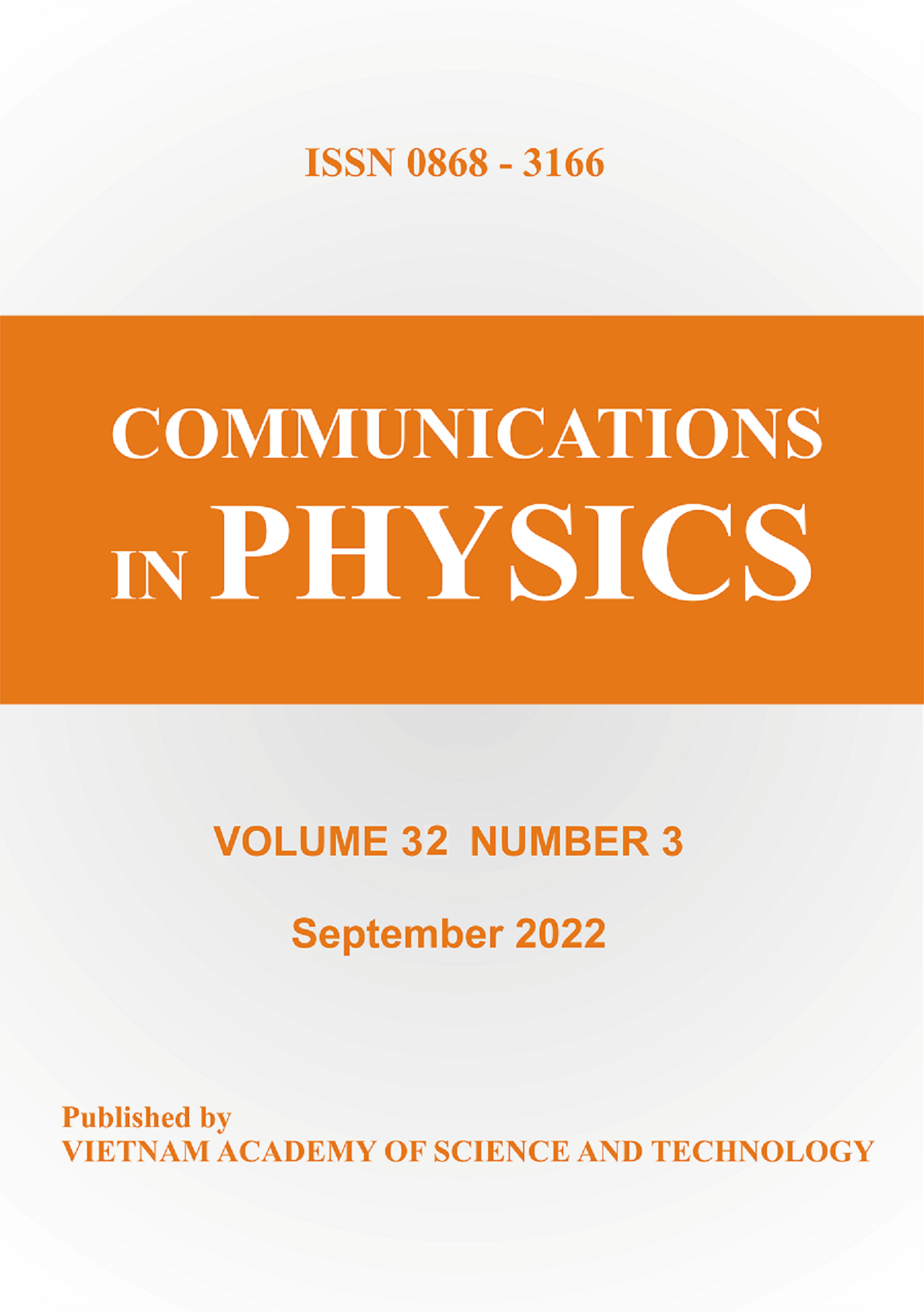In silico Probing Ca2+ And Zn2+ Permeable Transmembrane 4Aβ1-42 Barrel
Author affiliations
DOI:
https://doi.org/10.15625/0868-3166/15319Keywords:
Amyloid, Ion channel, tetramer barrel, US, FPL, Ca2 , Zn2Abstract
Alzheimer’s disease is known as one of the most popular forms of dementia affecting numerous people worldwide. The Amyloid beta (Aβ) peptides form to oligomeric conformations that cause the intracellular Ca2+ and Zn2+ abnormality leading to the death of neuron cells. The failure of AD therapy targeting Aβ oligomers probably caused by misunderstanding the ions transport through transmembrane Aβ (tmAβ) ion-like channel since Aβ oligomers transiently exist in a mixture order of Aβ oligomers. The high-resolution of tmAβ peptides are thus unavailable until the date. Fortunately, computational approaches are able to complement the missing experimental structures. The transmembrane 4Aβ1-42 (tm4Aβ1-42) barrel, one of the most neurotoxic elements, was thus predicted in the previous work. Therefore, in this context, the Ca2+/Zn2+ ions transport through the tm4Aβ1-42 barrel was investigated by using the fast pulling of ligand (FPL) and umbrella sampling (US) methods. Good consistent results were obtained implying that Ca2+ ion transport through tm4Aβ1-42 barrel with a lower free energy barrier compared with Zn2+ ion. The obtained results about Ca2+/Zn2+ transport across tmAβ1-42 barrel probably enhances the AD therapy
Downloads
Metrics
References
Selkoe, D.J. The Molecular Pathology of Alzheimer's Disease. Neuron, 6 (1991) 487-98. DOI: https://doi.org/10.1016/0896-6273(91)90052-2
Querfurth, H.W., LaFerla, F.M. Alzheimer's disease. N. Engl. J. Med., 362 (2010) 329-44. DOI: https://doi.org/10.1056/NEJMra0909142
Selkoe, D.J., Hardy, J. The Amyloid hypothesis of Alzheimer's disease at 25 years. EMBO Mol. Med., 8 (2016) 595-608. DOI: https://doi.org/10.15252/emmm.201606210
Bitan, G., Kirkitadze, M.D., Lomakin, A., Vollers, S.S., Benedek, G.B., Teplow, D.B. Amyloid β-Protein (Aβ) Assembly: Aβ40 and Aβ42 Oligomerize through Distinct Pathways. Proc. Natl. Acad. Sci. U.S.A., 100 (2003) 330-5. DOI: https://doi.org/10.1073/pnas.222681699
Kirkitadze, M.D., Condron, M.M., Teplow, D.B. Identification and Characterization of Key Kinetic Intermediates in Amyloid β-Protein Fibrillogenesis. J. Mol. Biol., 312 (2001) 1103-19. DOI: https://doi.org/10.1006/jmbi.2001.4970
Ngo, S.T., Hung, H.M., Truong, D.T., Nguyen, M.T. Replica Exchange Molecular Dynamics Study of the Truncated Amyloid Beta (11-40) Trimer in Solution. Phys. Chem. Chem. Phys., 19 (2017) 1909-19. DOI: https://doi.org/10.1039/C6CP05511G
Ngo, S.T., Luu, X.-C., Nguyen, M.T., Le, C.N., Vu, V.V. In silico studies of solvated F19W amyloid β (11-40) trimer. RSC Advances, 7 (2017) 42379-86. DOI: https://doi.org/10.1039/C7RA07187F
Ngo, S.T., Truong, D.T., Tam, N.M., Nguyen, M.T. EGCG Inhibits the Oligomerization of Amyloid Beta (16-22) Hexamer: Theoretical Studies. J. Mol. Graph. Model., 76 (2017) 1-10. DOI: https://doi.org/10.1016/j.jmgm.2017.06.018
Jarvis, L.M. Clinical Trial Failures. Chem. Eng. News, 90 (2012) 8. DOI: https://doi.org/10.1021/cen-09033-notw6
Abbott, A., Dolgin, E. Failed Alzheimer's Trial does not Kill Leading Theory of Disease. Nature, 540 (2016) 15-6. DOI: https://doi.org/10.1038/nature.2016.21045
Panza, F., Solfrizzi, V., Imbimbo, B.P., Logroscino, G. Amyloid-directed monoclonal antibodies for the treatment of Alzheimer’s disease: the point of no return? Expert Opin Biol Ther, 14 (2014) 1465-76. DOI: https://doi.org/10.1517/14712598.2014.935332
Rosenblum, W.I. Why Alzheimer trials fail: removing soluble oligomeric beta amyloid is essential, inconsistent, and difficult. Neurobiol Aging, 35 (969-74. DOI: https://doi.org/10.1016/j.neurobiolaging.2013.10.085
Doig, A.J., del Castillo-Frias, M.P., Berthoumieu, O., Tarus, B., Nasica-Labouze, J., Sterpone, F., et al. Why Is Research on Amyloid-β Failing to Give New Drugs for Alzheimer’s Disease? ACS Chem Neurosci, 8 (2017) 1435-7. DOI: https://doi.org/10.1021/acschemneuro.7b00188
Lal, R., Lin, H., Quist, A.P. Amyloid beta ion channel: 3D structure and relevance to amyloid channel paradigm. BBA - Biomembranes, 1768 (2007) 1966-75. DOI: https://doi.org/10.1016/j.bbamem.2007.04.021
Connelly, L., Jang, H., Teran Arce, F., Capone, R., Kotler, S.A., Ramachandran, S., et al. Atomic Force Microscopy and MD Simulations Reveal Pore-Like Structures of All-d-Enantiomer of Alzheimer’s β-Amyloid Peptide: Relevance to the Ion Channel Mechanism of AD Pathology. J. Phys. Chem. B, 116 (2012) 1728-35. DOI: https://doi.org/10.1021/jp2108126
Ngo, S.T., Derreumaux, P., Vu, V.V. Probable Transmembrane Amyloid α-Helix Bundles Capable of Conducting Ca2+ Ions. J. Phys. Chem. B, 123 (2019) 2645–53. DOI: https://doi.org/10.1021/acs.jpcb.8b10792
Nguyen, P.H., Campanera, J.M., Ngo, S.T., Loquet, A., Derreumaux, P. Tetrameric Aβ40 and Aβ42 β-Barrel Structures by Extensive Atomistic Simulations. I. In a Bilayer Mimicking a Neuronal Membrane. J. Phys. Chem. B, 123 (2019) 3643-8. DOI: https://doi.org/10.1021/acs.jpcb.9b01206
Tran, L., Basdevant, N., Prévost, C., Ha-Duong, T. Structure of Ring-Shaped Aβ42 Oligomers Determined by Conformational Selection. Scientific Reports, 6 (2016) 21429. DOI: https://doi.org/10.1038/srep21429
Tamano, H., Takeda, A. Age-Dependent Modification of Intracellular Zn2+ Buffering in the Hippocampus and Its Impact. Biol Pharm Bull, 42 (2019) 1070-5. DOI: https://doi.org/10.1248/bpb.b18-00631
Arispe, N., Pollard, H.B., Rojas, E. Zn2+ interaction with Alzheimer amyloid beta protein calcium channels. Proc. Natl. Acad. Sci. U.S.A, 93 (1996) 1710-5. DOI: https://doi.org/10.1073/pnas.93.4.1710
Corona, C., Pensalfini, A., Frazzini, V., Sensi, S.L. New therapeutic targets in Alzheimer's disease: brain deregulation of calcium and zinc. Cell Death Dis, 2 (2011) e176-e. DOI: https://doi.org/10.1038/cddis.2011.57
Oostenbrink, C., Villa, A., Mark, A.E., Van Gunsteren, W.F. A Biomolecular Force Field Based on the Free Enthalpy of Hydration and Solvation: The GROMOS Force-Field Parameter Sets 53A5 and 53A6. J. Comput. Chem., 25 (2004) 1656-76. DOI: https://doi.org/10.1002/jcc.20090
Nagle, J.F. Area/Lipid of Bilayers from NMR. Biophys. J., 64 (1993) 1476-81. DOI: https://doi.org/10.1016/S0006-3495(93)81514-5
Abraham, M.J., Murtola, T., Schulz, R., Páll, S., Smith, J.C., Hess, B., et al. GROMACS: High Performance Molecular Simulations through Multi-Level Parallelism from Laptops to Supercomputers. SoftwareX, 1–2 (2015) 19-25. DOI: https://doi.org/10.1016/j.softx.2015.06.001
Ngo, S.T. Computational Investigations of the Transmembrane Italian-Mutant (E22K) 3Aβ11−40 in Aqueous Solution. Communications in Physics, 28 (2018) 265-76. DOI: https://doi.org/10.15625/0868-3166/28/3/12773
Darden, T., York, D., Pedersen, L. Particle mesh Ewald: An N⋅log(N) method for Ewald sums in large systems. J. Chem. Phys., 98 (1993) 10089-92. DOI: https://doi.org/10.1063/1.464397
Ngo, S.T., Hung, H.M., Nguyen, M.T. Fast and Accurate Determination of the Relative Binding Affinities of Small Compounds to HIV-1 Protease using Non-Equilibrium Work. J. Comput. Chem., 37 (2016) 2734-42. DOI: https://doi.org/10.1002/jcc.24502
Ngo, S.T., Nguyen, M.T., Nguyen, M.T. Determination of the absolute binding free energies of HIV-1 protease inhibitors using non-equilibrium molecular dynamics simulations. Chem. Phys. Lett., 676 (2017) 12-7. DOI: https://doi.org/10.1016/j.cplett.2017.03.034
Torrie, G.M., Valleau, J.P. Nonphysical sampling distributions in Monte Carlo free-energy estimation: Umbrella sampling. J. Comput. Phys., 23 (1977) 187-99. DOI: https://doi.org/10.1016/0021-9991(77)90121-8
Hub, J.S., de Groot, B.L., van der Spoel, D. g_wham—A Free Weighted Histogram Analysis Implementation Including Robust Error and Autocorrelation Estimates. J. Chem. Theory Comput., 6 (2010) 3713-20. DOI: https://doi.org/10.1021/ct100494z
Efron, B. Bootstrap Methods: Another Kook at the Jackknife. Ann. Stat., 7 (1979) 1-26. DOI: https://doi.org/10.1214/aos/1176344552
Petrache, H.I., Dodd, S.W., Brown, M.F. Area per Lipid and Acyl Length Distributions in Fluid Phosphatidylcholines Determined by (2)H NMR Spectroscopy. Biophys. J., 79 (2000) 3172-92. DOI: https://doi.org/10.1016/S0006-3495(00)76551-9
Ngo, S.T., Nguyen, M.T., Nguyen, N.T., Vu, V.V. The Effects of A21G Mutation on Transmembrane Amyloid Beta (11–40) Trimer: an In Silico Study. J. Phys. Chem. B, 121 (2017) 8467-74. DOI: https://doi.org/10.1021/acs.jpcb.7b05906
Ngo, S.T., Hung, H.M., Tran, K.N., Nguyen, M.T. Replica Exchange Molecular Dynamics Study of the Amyloid Beta (11-40) Trimer Penetrating a Membrane. RSC Adv., 7 (2017) 7346-57. DOI: https://doi.org/10.1039/C6RA26461A
Tieleman, D.P., Marrink, S.J., Berendsen, H.J.C. A Computer Perspective of Membranes: Molecular Dynamics Studies of Lipid Bilayer Systems. BBA-Rev. Biomembranes, 1331 (1997) 235-70. DOI: https://doi.org/10.1016/S0304-4157(97)00008-7
Hung, H.M., Nguyen, V.P., Ngo, S.T., Nguyen, M.T. Theoretical Study of the Interactions between the first Transmembrane Segment of NS2 Protein and a POPC Lipid Bilayer. BioPhys Chem, 217 (2016) 1-7. DOI: https://doi.org/10.1016/j.bpc.2016.07.001
Di Scala, C., Yahi, N., Boutemeur, S., Flores, A., Rodriguez, L., Chahinian, H., et al. Common molecular mechanism of amyloid pore formation by Alzheimer’s β-amyloid peptide and α-synuclein. Sci Rep, 6 (2016) 28781. DOI: https://doi.org/10.1038/srep28781
Downloads
Published
How to Cite
Issue
Section
License
Authors who publish with CIP agree with the following terms:- The manuscript is not under consideration for publication elsewhere. When a manuscript is accepted for publication, the author agrees to automatic transfer of the copyright to the editorial office.
- The manuscript should not be published elsewhere in any language without the consent of the copyright holders. Authors have the right to enter into separate, additional contractual arrangements for the non-exclusive distribution of the journal’s published version of their work (e.g., post it to an institutional repository or publish it in a book), with an acknowledgement of its initial publication in this journal.
- Authors are encouraged to post their work online (e.g., in institutional repositories or on their websites) prior to or during the submission process, as it can lead to productive exchanges or/and greater number of citation to the to-be-published work (See The Effect of Open Access).
Accepted 29-10-2020
Published 06-01-2021












